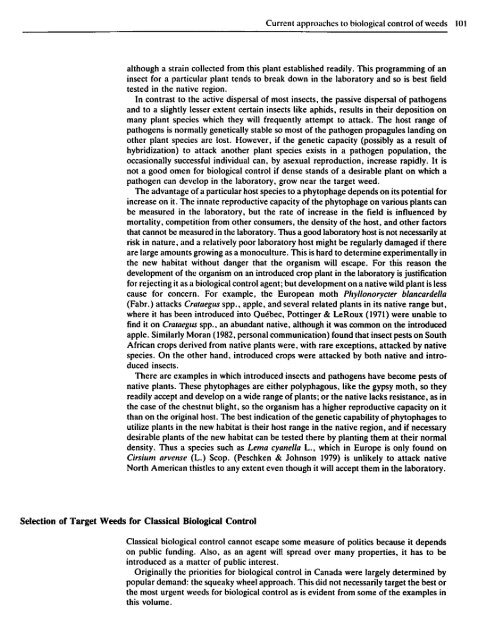pdf, 57.71Mb - Entomological Society of Canada
pdf, 57.71Mb - Entomological Society of Canada
pdf, 57.71Mb - Entomological Society of Canada
You also want an ePaper? Increase the reach of your titles
YUMPU automatically turns print PDFs into web optimized ePapers that Google loves.
Current approaches to biological control <strong>of</strong> weeds 101<br />
although a strain collected from this plant established readily. This programming <strong>of</strong> an<br />
insect for a particular plant tends to break down in the laboratory and so is best field<br />
tested in the native region.<br />
In contrast to the active dispersal <strong>of</strong> most insects, the passive dispersal <strong>of</strong> pathogens<br />
and to a slightly lesser extent certain insects like aphids, results in their deposition on<br />
many plant species which they will frequently attempt to attack. The host range <strong>of</strong><br />
pathogens is normally genetically stable so most <strong>of</strong> the pathogen propagules landing on<br />
other plant species are lost. However, if the genetic capacity (possibly as a result <strong>of</strong><br />
hybridization) to attack another plant species exists in a pathogen popUlation, the<br />
occasionally successful individual can, by asexual reproduction, increase rapidly. It is<br />
not a good omen for biological control if dense stands <strong>of</strong> a desirable plant on which a<br />
pathogen can develop in the laboratory, grow near the target weed.<br />
The advantage <strong>of</strong> a particular host species to a phytophage depends on its potential for<br />
increase on it. The innate reproductive capacity <strong>of</strong> the phytophage on various plants can<br />
be measured in the laboratory, but the rate <strong>of</strong> increase in the field is influenced by<br />
mortality, competition from other consumers, the density <strong>of</strong> the host, and other factors<br />
that cannot be measured in the laboratory. Thus a good laboratory host is not necessarily at<br />
risk in nature, and a relatively poor laboratory host might be regularly damaged if there<br />
are large amounts growing as a monoculture. This is hard to determine experimentally in<br />
the new habitat without danger that the organism will escape. For this reason the<br />
development <strong>of</strong> the organism on an introduced crop plant in the laboratory is justification<br />
for rejecting it as a biological control agent; but development on a native wild plant is less<br />
cause for concern. For example, the European moth Plryllonorycter blancardella<br />
(Fabr.) attacks Cratueglls spp., apple, and several related plants in its native range but,<br />
where it has been introduced into Quebec, Pottinger & LeRoux (1971) were unable to<br />
find it on Cratueglls spp., an abundant native, although it was common on the introduced<br />
apple. Similarly Moran (1982, personal communication) found that insect pests on South<br />
African crops derived from native plants were, with rare exceptions, attacked by native<br />
species. On the other hand, introduced crops were attacked by both native and introduced<br />
insects.<br />
There are examples in which introduced insects and pathogens have become pests <strong>of</strong><br />
native plants. These phytophages are either polyphagous, like the gypsy moth, so they<br />
readily accept and develop on a wide range <strong>of</strong> plants; or the native lacks resistance, as in<br />
the case <strong>of</strong> the chestnut blight, so the organism has a higher reproductive capacity on it<br />
than on the original host. The best indication <strong>of</strong> the genetic capability <strong>of</strong> phytophages to<br />
utilize plants in the new habitat is their host range in the native region, and if necessary<br />
desirable plants <strong>of</strong> the new habitat can be tested there by planting them at their normal<br />
density. Thus a species such as Lema cyan ella L., which in Europe is only found on<br />
Cirs;llm arvense (L.) Scop. (Peschken & Johnson 1979) is unlikely to attack native<br />
North American thistles to any extent even though it will accept them in the laboratory.<br />
Selection <strong>of</strong> Target Weeds for Classical Biological Control<br />
Classical biological control cannot escape some measure <strong>of</strong> politics because it depends<br />
on public funding. Also, as an agent will spread over many properties, it has to be<br />
introduced as a matter <strong>of</strong> public interest.<br />
Originally the priorities for biological control in <strong>Canada</strong> were largely determined by<br />
popular demand: the squeaky wheel approach. This did not necessarily target the best or<br />
the most urgent weeds for biological control as is evident from some <strong>of</strong> the examples in<br />
this volume.
















